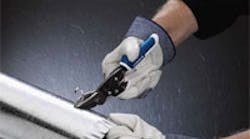By Lee 'Hackman' Breton
On-the-job safety measures can easily be overlooked. HVAC technicians use their tools so regularly, they may sometimes forget to take the extra steps that ensure safety.
Technicians will do themselves a favor by performing regular tool safety checks, and by remaining aware of the hazards associated with hand tools and torches when used in HVAC applications.
There are many inherent dangers associated with HVAC applications. If tools are used improperly or without appropriate protective gear, the level of workmanship can suffer at the very least and, at worst, may result in injury. Accidents can happen in a split second, so safety can’t be taken for granted. Reminding yourself of these simple safety rules throughout the day prevents injury and time loss on the job.
1. Hand tools
Snips. First, determine what type of cuts you need to make and which direction you’ll need to cut. All snips cut straight, but some have a slight angle to the blades that allow them to cut to the left or right. It’s important to choose the proper angle and never force snips to cut in a direction in which they’re not designed to go. Using the wrong tool for a cut can lead to hand fatigue and may ultimately result in injury.
Features to look for in snips:
- 1074 high carbon steel blades for ultimate strength and sharpness
- precision-formed blades for long, even cuts
- high-grade, reinforced springs
- dual material handles that won’t slip or twist
- well-oiled blades for smooth operation.
Utility knives. A sharper knife blade can actually keep you from cutting yourself and help you make safer, more accurate cuts. Utility knives that are dull or sticky are prone to breaking or jumping. Be sure to choose sturdy, high-tech utility blades that are shatter-resistant and can bend without breaking.
Remember to always use eye protection, and stand to the side of whatever you’re cutting Wrenches. Select the right size and length for the job, and never use a wrench that is too short, or put a pipe over the handle for leverage. If you’re pulling on the wrench, make sure you’re out of the way. To prevent slipping, be sure that the wrench jaws are as tight as possible around the pipe.
2. Saw blades
Match the blade to pipe size. Be sure that the blade is at least 2-in. longer than the diameter of the pipe — a blade that is too short will bottom out inside the pipe and buckle. Let the blade do the work. Overfeeding generates excessive heat and sparks, and can prematurely wear out the blade.
Make sure the pipe is secured firmly; if the pipe moves or spins during the cut, it can damage the blade and the piece being cut, and could potentially result in injury. To greatly reduce the chance of a spark when cutting metal, mix dishwashing soap with water in a spray bottle and have an assistant spray it on the blade during the cutting.
3. Brazing
The safety precautions associated with welding/cutting apply to brazing:
- Always ventilate the area
- Wear eye and hand protection
- Take caution near flammable materials
- Clean all base metals thoroughly to remove unknown contaminants that may cause dangerous fumes
- Isolate flammable materials
- Do not braze charged systems
- Do not use if there are leaks or cracks in welding hoses
- Heat properly and evenly to ensure additional fumes are not produced by overheating in one area
- Perform safety checks before each use.
(For additional information on welding safety, see the American National Standard Z49.1-1967, Safety in Welding and Cutting, published by the American Welding Society (AWS), 550 NW LeJeune Rd., Miami, FL 33126. Also refer to the U.S. Department of Labor, OSHA 1926.350, Gas Welding & Cutting.)
Using a fluxing agent. Flux is a chemical compound used to clean and prepare a surface for brazing, and to help prevent the build-up of oxides that can inhibit proper joint strength and adhesion during the brazing process. When using a flux, apply only to surfaces being joined, making sure to remove all excess flux. Flux is corrosive and, if left on the surface after the brazing process, may weaken the joint over time. Always check the Material Safety Data Sheet of the flux before use.
Brazing the assembly. When heating the assembly to be joined, it’s important to make sure the inside and outside of the surfaces to be joined are properly heated for required flow of the alloy and the filling of all voids. Differences in metals, thicknesses, and diameter of tubing require differing amounts of time to heat to the proper temperature. Even heating of the area to be filled by the alloy helps ensure that all voids are filled and the assembly is strong.
It’s All About Minimizing Risks
Using tools properly on the job will greatly reduce the chances of injury and lost time. Be aware of your surroundings, and the hazards associated with your tools to increase your own safety, and the safety of those around you. By making time for safety checks, and following through with them, you can greatly minimize your risk of an accident.
Lee “Hackman” Breton travels the world with “Team Hackman,” to demonstrate Lenox cutting blades. He cut his first car in half with a Lenox blade in 1981. He can be reached at 413/525-3961.
| Safety 'Tips To Work By'
|












